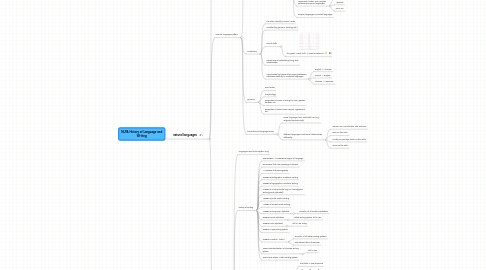
1. natural languages
1.1. some pictures
1.1.1. Language Evolution
1.1.1.1. http://www.userfriendly.org/
1.1.2. languages are historically related
1.1.3. Indo-European
1.1.3.1. http://andromeda.rutgers.edu/~jlynch/language.html
1.1.4. #speakers by language family
1.1.4.1. http://www.andaman.org/BOOK/reprints/weber/Weber-TopTen5.jpg
1.1.5. #speakers by language
1.2. how do languages differ?
1.2.1. phonology
1.2.1.1. the sounds and constraints on the sounds that languages use
1.2.1.2. there is a fairly common inventory of basic sounds
1.2.1.2.1. consonants like t, d, p, b, k, g
1.2.1.2.2. vowels like a, e, i, o, u
1.2.1.2.3. nasals, fricatives, liquids like m, n, sh, r, l
1.2.1.3. there is a common set of syllabic structures
1.2.1.3.1. CV
1.2.1.3.2. CVC
1.2.1.4. more unusual distinctions
1.2.1.4.1. tonal languages (Chinese)
1.2.1.4.2. pitch stress (Japanese)
1.2.1.4.3. large vowel inventory (English)
1.2.1.4.4. trills and clicks (Africa)
1.2.1.4.5. uvular and velar consonants
1.2.1.4.6. consonant clusters and complex syllables (European languages)
1.2.1.4.7. whisper languages, invented languages
1.2.2. vocabulary
1.2.2.1. can often identify common roots
1.2.2.2. modified by grammar (endings etc.)
1.2.2.3. sound shifts
1.2.2.3.1. the great "vowel shift" ("vowel movement" :-)
1.2.2.4. easiest way of establishing long-term relationships
1.2.2.5. complicated by frequent borrowing beteween otherwise distantly or unrelated languages
1.2.2.5.1. English -> Chinese
1.2.2.5.2. French -> English
1.2.2.5.3. Chinese -> Japanese
1.2.3. grammar
1.2.3.1. word order
1.2.3.2. morphology
1.2.3.3. properties of nouns: marking for case, gender, number, etc.
1.2.3.4. properties of verbs: tense, aspect, agreement, etc.
1.2.4. honorifics and language levels
1.2.4.1. some languages have restricted use (e.g., religious functions only)
1.2.4.2. different languages mark social relationships differently
1.2.4.2.1. "Können Sie mir bitte das Salz reichen?"
1.2.4.2.2. "Gib mir das Salz."
1.2.4.2.3. "Could you perhaps hand me the salt?"
1.2.4.2.4. "Give me the salt!"
1.3. writing systems
1.3.1. languages used to be spoken only
1.3.2. history of writing
1.3.2.1. 400'000BCE - 100'000BCE origins of language
1.3.2.2. 40'000BCE first cave paintings in Europe
1.3.2.3. 11'000BCE first pornography
1.3.2.4. 3400BCE pictographic cuneiform writing
1.3.2.5. 2900BCE logographic cuneiform writing
1.3.2.6. 2700BCE 22 consonantal signs in hieroglyphic writing (proto-alphabet)
1.3.2.7. 1850BCE proto sinaitic writing
1.3.2.8. 1425BCE ancient Greek writing
1.3.2.9. 1200BCE Phoenician alphabet
1.3.2.9.1. ancestor of all modern alphabets
1.3.2.10. 800BCE Greek alphabet
1.3.2.10.1. oldest writing system still in use
1.3.2.11. 500BCE Latin alphabet
1.3.2.11.1. still in use today
1.3.2.12. 300BCE Maya writing system
1.3.2.13. 260BCE Sanskrit / Prakrit
1.3.2.13.1. ancestor of all Indian writing systems
1.3.2.13.2. also derived from Phoenician
1.3.2.14. 200CE standardization of Chinese writing system
1.3.2.14.1. still in use
1.3.2.15. 500CE pre-Islamic Arabic writing system
1.3.3. types of writing system
1.3.3.1. alphabetic writing system
1.3.3.1.1. one letter = one phoneme
1.3.3.1.2. Phoenician
1.3.3.1.3. Latin
1.3.3.1.4. Greek
1.3.3.1.5. Korean Hangul
1.3.3.2. syllabic writing system
1.3.3.2.1. one character = one syllable
1.3.3.2.2. Japanese Katakana / Hiragana
1.3.3.2.3. Linear-B (ancient Greek)
1.3.3.3. logographic writing system
1.3.3.3.1. one character = one word or morpheme
1.3.3.3.2. Chinese
1.3.3.3.3. Japanese Kanji (based on Chinese)
1.3.3.3.4. Hieroglyphics
1.3.4. other common phenomena related to writing
1.3.4.1. reading order
1.3.4.2. whitespace
1.3.4.3. punctuation
